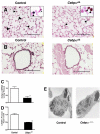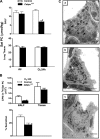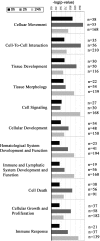C/EBP{alpha} is required for pulmonary cytoprotection during hyperoxia
- PMID: 19465518
- PMCID: PMC2742785
- DOI: 10.1152/ajplung.00094.2009
C/EBP{alpha} is required for pulmonary cytoprotection during hyperoxia
Abstract
A number of transcriptional pathways regulating fetal lung development are active during repair of the injured lung. We hypothesized that C/EBPalpha, a transcription factor critical for lung maturation, plays a role in protection of the alveolar epithelium following hyperoxic injury of the mature lung. Transgenic Cebpalpha(Delta/Delta) mice, in which Cebpalpha was conditionally deleted from Clara cells and type II cells after birth, were developed. While no pulmonary abnormalities were observed in the Cebpalpha(Delta/Delta) mice (7-8 wk old) under normal conditions, the mice were highly susceptible to hyperoxia. Cebpalpha(Delta/Delta) mice died within 4 days of exposure to 95% oxygen in association with severe lung inflammation, altered maturation of surfactant protein B and C, decreased surfactant lipid secretion, and abnormal lung mechanics at a time when all control mice survived. mRNA microarray analysis of isolated type II cells at 0, 2, and 24 h of hyperoxia demonstrated the reduced expression of number of genes regulating surfactant lipid and protein homeostasis, including Srebf, Scap, Lpcat1, Abca3, Sftpb, and Napsa. Genes influencing cell signaling or immune responses were induced in the lungs of Cebpalpha(Delta/Delta) mice. C/EBPalpha was required for the regulation of genes associated with surfactant lipid homeostasis, surfactant protein biosynthesis, processing and transport, defense response to stress, and cell redox homeostasis during exposure to hyperoxia. While C/EBPalpha did not play a critical role in postnatal pulmonary function under normal conditions, C/EBPalpha mediated protection of the lung during acute lung injury induced by hyperoxia.
Figures









 B indicates binding; A → B indicates A is the cause of B; A
B indicates binding; A → B indicates A is the cause of B; A B indicates A inhibits B, and
B indicates A inhibits B, and  indicates self-regulation. The mRNA expression of cluster 3 genes was negatively correlated with the length of hyperoxia exposure time and color coded in green. Positively correlated genes are color coded in pink. Many genes in the network were known to be involved in synthesis, processing, and regulation of surfactant proteins and lipids.
indicates self-regulation. The mRNA expression of cluster 3 genes was negatively correlated with the length of hyperoxia exposure time and color coded in green. Positively correlated genes are color coded in pink. Many genes in the network were known to be involved in synthesis, processing, and regulation of surfactant proteins and lipids.
References
-
- Andreani M, Olivier JL, Berenbaum F, Raymondjean M, Bereziat G. Transcriptional regulation of inflammatory secreted phospholipases A(2). Biochim Biophys Acta 1488: 149–158, 2000. - PubMed
-
- Bartlett GR Phosphorus assay in column chromatography. J Biol Chem 234: 466–468, 1959. - PubMed
-
- Berg T, Didon L, Nord M. Ectopic expression of C/EBPalpha in the lung epithelium disrupts late lung development. Am J Physiol Lung Cell Mol Physiol 291: L683–L693, 2006. - PubMed
-
- Berruyer C, Pouyet L, Millet V, Martin FM, LeGoffic A, Canonici A, Garcia S, Bagnis C, Naquet P, Galland F. Vanin-1 licenses inflammatory mediator production by gut epithelial cells and controls colitis by antagonizing peroxisome proliferator-activated receptor gamma activity. J Exp Med 203: 2817–2827, 2006. - PMC - PubMed
Publication types
MeSH terms
Substances
Grants and funding
LinkOut - more resources
Full Text Sources
Molecular Biology Databases
Miscellaneous

